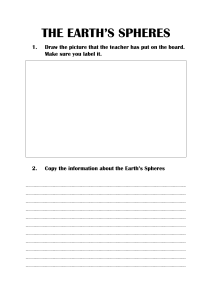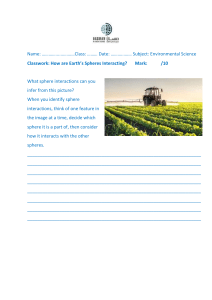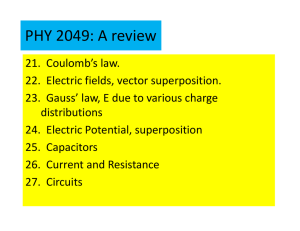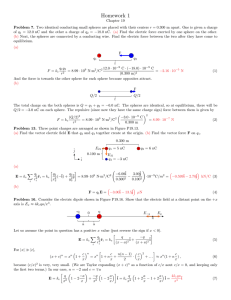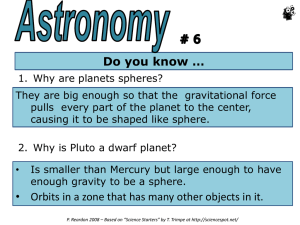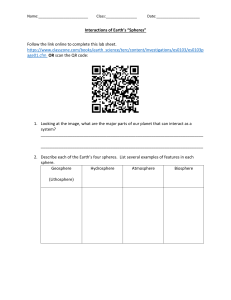Earth System Science Lesson Plan: Spheres & Interactions
advertisement
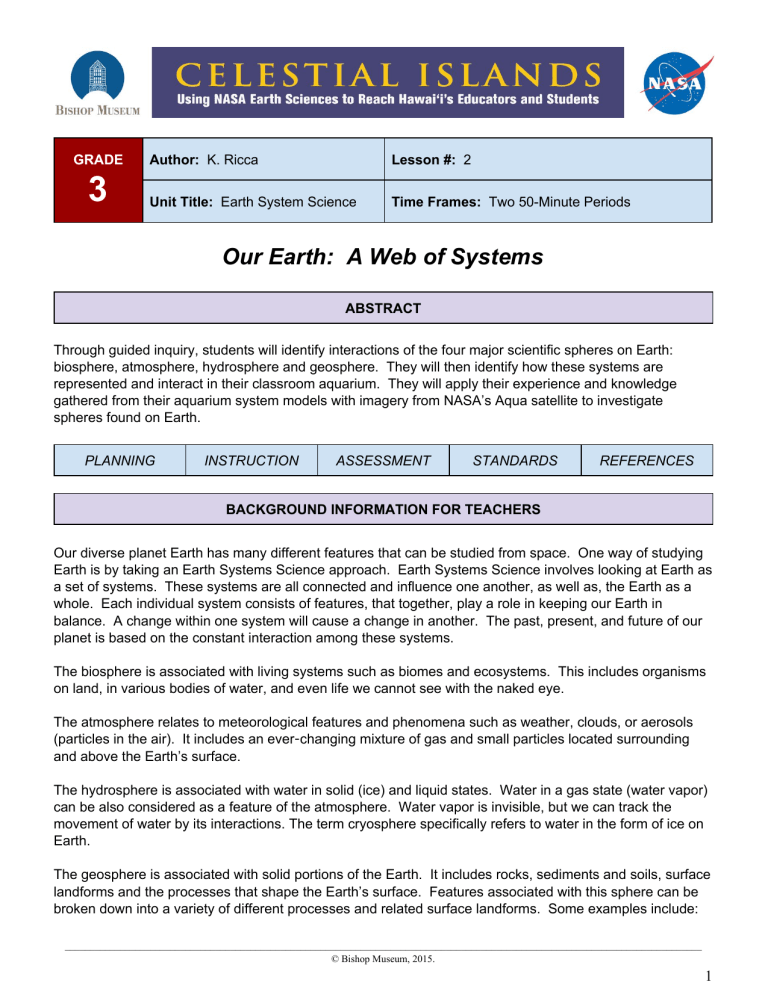
GRADE 3 Author: K. Ricca Lesson #: 2 Unit Title: Earth System Science Time Frames: Two 50­Minute Periods Our Earth: A Web of Systems ABSTRACT Through guided inquiry, students will identify interactions of the four major scientific spheres on Earth: biosphere, atmosphere, hydrosphere and geosphere. They will then identify how these systems are represented and interact in their classroom aquarium. They will apply their experience and knowledge gathered from their aquarium system models with imagery from NASA’s Aqua satellite to investigate spheres found on Earth. PLANNING INSTRUCTION ASSESSMENT STANDARDS REFERENCES BACKGROUND INFORMATION FOR TEACHERS Our diverse planet Earth has many different features that can be studied from space. One way of studying Earth is by taking an Earth Systems Science approach. Earth Systems Science involves looking at Earth as a set of systems. These systems are all connected and influence one another, as well as, the Earth as a whole. Each individual system consists of features, that together, play a role in keeping our Earth in balance. A change within one system will cause a change in another. The past, present, and future of our planet is based on the constant interaction among these systems. The biosphere is associated with living systems such as biomes and ecosystems. This includes organisms on land, in various bodies of water, and even life we cannot see with the naked eye. The atmosphere relates to meteorological features and phenomena such as weather, clouds, or aerosols (particles in the air). It includes an ever‐changing mixture of gas and small particles located surrounding and above the Earth’s surface. The hydrosphere is associated with water in solid (ice) and liquid states. Water in a gas state (water vapor) can be also considered as a feature of the atmosphere. Water vapor is invisible, but we can track the movement of water by its interactions. The term cryosphere specifically refers to water in the form of ice on Earth. The geosphere is associated with solid portions of the Earth. It includes rocks, sediments and soils, surface landforms and the processes that shape the Earth’s surface. Features associated with this sphere can be broken down into a variety of different processes and related surface landforms. Some examples include: _______________________________________________________________________________________________________________________________ © Bishop Museum, 2015. 1 erosion, volcanism, and plate tectonic movement. Alternate terms that also refer to these terrestrial features are lithosphere or crust. Image courtesy of Bishop Museum. PLANNING Essential Questions ● How do I fit into Earth’s systems? ● How can observing our aquarium system model help us figure out what’s happening in the Earth’s systems? Instructional Objectives Students will: ● Identify and describe Earth’s four spheres. ● Formulate new understandings of Earth’s spheres. ● Recognize and explain the interactions between Earth’s spheres found in aquarium model. ● Communicate their understandings in discussions, with a science notebook and an organizing worksheet. Key Vocabulary ● Biosphere ● Atmosphere ● Hydrosphere ● Geosphere BACK TO TOP INSTRUCTION _______________________________________________________________________________________________________________________________ © Bishop Museum, 2015. 2 Materials ● Class aquariums ● The Globe Program: All About Earth, Our World On Stage ● “ Earth’s Spheres ” PowerPoint presentation ● Digital Projector ● Class set of “Earth’s Spheres,” “Sphere Interactions” and “Session Two Assessment” worksheets ● “Earth System Song” for each student ● Poster board and art/craft materials ● The Air We Breathe (optional) Preparation ● Make class sets of worksheets and the “Earth System Song” ● Download “Earth’s Spheres” PowerPoint presentation ● Provide posterboard and art materials ● Set up class aquariums so they are visible to students Resources NASA: ● Read Aloud ­ The Globe Program: All About Earth, Our World On Stage: http://www.globe.gov/documents/348830/350113/ElementaryGLOBE_EarthSystems_en .pdf ● Earth Observatory Image of the Day: http://earthobservatory.nasa.gov/IOTD/view.php ● Global Precipitation Measurement Glossary: http://pmm.nasa.gov/education/glossary ● Read Aloud ­ The Air We Breathe http://www.nasa.gov/pdf/62452main_The_Air_We_Breathe.pdf Bishop Museum: ● “Earth’s Spheres” PowerPoint presentation: ENGAGE Session One: 1. Students observe aquariums and quietly reflect with partners, groups, or class on the following review questions: ● ● ● ● ● ● ● What are the different parts found in our aquarium? How are these parts alike? What do they have in common? How are they different? How do they work together in the aquarium system? What interactions do they have together? How do these interactions change the aquarium system? Do they help the system? What could change the aquarium system? 2. Students will discuss how these parts are connected in their aquarium and investigate how they represent similar connections found on Earth. ● Read Aloud ­ All About Earth, Our World On Stage ● Students discuss different spheres mentioned in story. They will most likely refer to them as air, land, water, and living things. _______________________________________________________________________________________________________________________________ © Bishop Museum, 2015. 3 ● ● ● Use “Earth’s Spheres” worksheet to guide students to identify each sphere by scientific name. Students then work with partners or groups to describe each sphere based on information learned from story. Students then add these new vocabulary words to their science notebooks in the vocabulary section. EXPLORE 1. Refocus students’ attention back to aquarium. 2. Using the “Earth’s Spheres” worksheet as support, students will identify which parts of aquarium model could represent the different spheres of Earth. 3. What part of the aquarium represents: ● ● ● ● The hydrosphere? The atmosphere? The biosphere? The geosphere? 4. Students may struggle with atmosphere because it is invisible. Air is often forgotten, yet vital. You can’t see it, but you can observe its interactions with other spheres. Some students may already have this background knowledge, but you may need to guide others in understanding that fish breathe oxygen that’s found in water through their gills. If you feel students need significant background knowledge about the atmosphere, please share and discuss the read aloud The Air We Breathe prior to this activity. 5. Show students images from NASA’s Aqua satellite in the PowerPoint presentation “Earth’s Spheres.” 6. Students brainstorm and write down which spheres they see in their science notebooks. Students should write down their reasons for their choice. 7. Call on students to explain which spheres were chosen for each image and why they made that choice. While students are listening to their peers, they may make changes to their own ideas in their notebook. EXPLAIN Session Two: 1. Divide class into four groups so there is one group for each of Earth’s spheres. Students should have access to their “Earth’s Spheres” worksheet from session one. Students will first revisit the scientific name of their sphere, describe it and identify the aquarium part that models that sphere. 2. Students think back to their discussion from Session One about how the parts of the aquarium are dependent on each other. Revisit aquarium interactions. _______________________________________________________________________________________________________________________________ © Bishop Museum, 2015. 4 3. Students then need to find two interactions with their sphere to other spheres found in their aquarium model. Provide students with example scenarios of interactions and how to use sentences starters by using a projector or other way to display the “Earth’s Spheres” worksheet. Example: ● One group is assigned biosphere. They first write down general information they’ve learned about the biosphere from the previous lesson. They then choose a part of the aquarium that represents the biosphere, (e.g. plant). They write down interactions the plant has with other parts of the aquarium. The plant interacts with water (hydrosphere) because it needs water to live. It is also interacts with air (atmosphere) because plants need air to grow. Some students may even know that plants get carbon dioxide from the fish and gives the fish oxygen. 4. Pass out “Sphere Interactions” worksheet. Students use the worksheet with sentence starters to share their thinking. 5. Each group reports their findings to the class. EXTEND 1. Students read and practice singing “The Earth System Song”. Students write or illustrate the sphere for each verse in the margins. 2. Students can work in partners or groups to create a poster that illustrates examples of each sphere. EVALUATE 1. Pass out “Session Two Assessment” worksheet. Students draw arrows from one part of the aquarium system to another. 2. Students explain their interactions by writing sentences in their science notebook. BACK TO TOP ASSESSMENT OPTIONS Formative Assessment ● The teacher can determine initial student understanding of sphere interactions by observing and listening to student discussions during completion of “Sphere Interactions” worksheet. Students will demonstrate their understanding of a specific sphere by creating a group poster that illustrates and explains examples from that sphere. Summative Assessment ● Students will use the “Session Two Assessment” worksheet and draw three arrows from one object to another and explain their interactions by writing it in their science notebooks. BACK TO TOP _______________________________________________________________________________________________________________________________ © Bishop Museum, 2015. 5 CULTURE CONNECTION Image courtesy of F. Kovalchek. The traditional Hawaiian worldview has another way of classifying systems found on Earth. Papahulilani is the space from above the head to where the stars sit. It is inclusive of the Sun, moon, stars, planets, winds, clouds, and the measurement of the vertical and horizontal spaces of the atmosphere. It is also a class of experts who are spiritually, physically, and intellectually attuned to the space above and its relationship to Earth. Papahulihonua is inclusive of earth and ocean. It is the ongoing study of the natural Earth and ocean and its development, transformation and evolution by natural causes. It is also a class of experts who are spiritually, physically, and intellectually attuned to this Earth and its relationship to the space above and the life forms on it. Papahānaumoku moves from the embryonic state of all life forces to death. It is the birthing cycle of all flora and fauna inclusive of man. It is the process of investigating, questioning, analyzing and reflecting upon all things that give birth, regenerate and procreate. It is also a class of experts who are spiritually, physically and intellectually attuned to things born and the habitat that provides their nourishment, shelter, and growth (Edith Kanaka'ole Foundation, 2015). DIFFERENTIATION Emerging Learners ● Students can use their “Earth’s Spheres” and “Sphere Interactions” worksheets to help them determine the interactions between the parts in the aquarium for their summative assessment. Advanced Learners ● Students can create images of sphere examples found in nature and explain interactions with each other. English Language Learners ● Students should have key vocabulary accessible for all lesson activities. EXTENSIONS _______________________________________________________________________________________________________________________________ © Bishop Museum, 2015. 6 ● NASA, The Air We Breathe : http://www.nasa.gov/pdf/62452main_The_Air_We_Breathe.pdf Engage them in a discussion about what they can do to keep our atmosphere healthy. Image courtesy of Bishop Museum . ● Take a school trip to the Bishop Museum and visit the Richard T. Mamiya Science Adventure Center. This facility provides students with immersive and interactive experiences in earth system science. Students will be able to explore and see examples of all four of Earth’s spheres and further their foundational understanding of our Earth as a system. STANDARDS Next Generation Science Standards Crosscutting Concepts: ● Patterns ­ In grades 3­5, students identify similarities and differences in order to sort and classify natural objects and designed products. They identify patterns related to time, including simple rates of change and cycles, and to use these patterns to make predictions. ● Systems and System Models ­ In grades 3­5, students understand that a system is a group of related parts that make up a whole and can carry out functions its individual parts cannot. They can also describe a system in terms of its components and their interactions. Science and Engineering Practices: ● Planning and carrying out investigations ● Constructing explanations ● Developing and using models Disciplinary Core Idea: ● ESS2.A Earth Materials and Systems ­ Earth’s major systems are the geosphere (solid and molten rock, soil, and sediments), the hydrosphere (water and ice), the atmosphere (air), and the biosphere (living things, including humans). These systems interact in multiple ways to affect Earth’s surface materials and processes. Common Core ● W.3.2 Write informative/explanatory texts to examine a topic and convey ideas and information clearly. ● RI.3.1Ask and answer questions to demonstrate understanding of a text, referring explicitly to the text as the basis for the answers. ● RI.3.2Determine the main idea of a text, recount the key details and explain how they support the main idea. _______________________________________________________________________________________________________________________________ © Bishop Museum, 2015. 7 Hawaii Content & Performance Standards III ● SC.3.1.2 S afely collect and analyze data to answer a question. ● SC.3.3.1 Describe how plants depend on animals. ● SC.3.6.1 Define energy and explain that the Sun produces energy in the form of light and heat. ● SC.3.8.1 Describe different Earth materials (e.g., rocks, minerals, sand, soil) and explain their formation and composition. ● SC.3.8.2 Describe how the water cycle is related to weather and climate. General Learner Outcomes ● Self­Directed Learner ● Effective Communicator ● Complex Thinker ● Community Contributor BACK TO TOP REFERENCES Edith Kanaka'ole Foundation. Papakū Makawalu ­ Edith Kanaka‘ole Foundation.Retrieved April 19, 2015, from: https://www.edithkanakaolefoundation.org/current­projects/papaku­makawalu/ Hathaway, B., & Zarlengo, K. (2006). All about earth, our world on stage (1st ed., pp. 1­36). Boulder: University Corporation for Atmospheric Research. Retrieved from http://nasawavelength.org/resource/nw­000­000­002­803 Kovalchek, Frank. (Photographer). (2010). Painting of Kilauea [ Photograph]. Retrieved April 19, 2015, from: https://www.flickr.com/photos/72213316@N00/5692415826/ Ladd, Irene. The Air We Breathe . (n.d.). Retrieved January 14, 2016, from: http://www.nasa.gov/pdf/62452main_The_Air_We_Breathe.pdf Mottar, Jenny (Photographer). (n.d.). Hummingbirds [photograph]. Retrieved April 19, 2015, from: http://www.nasa.gov/topics/earth/features/climate_partners.html National Aeronautics and Space Administration. (2010). Spheres of Earth. Valderrama Graff, Paige. Retrieved from http://ares.jsc.nasa.gov/education/eeab/guides/SOE/SpheresOfEarth_StudentGuidev3.pdf Science Adventure Center [Photograph]. (n.d.). Retrieved April 28, 2015, from: http://www.bishopmuseum.org/exhibits/ Skofronick­Jackson, D. (n.d.). Glossary. Retrieved April 20, 2015, from http://pmm.nasa.gov/education/glossary [Untitled photograph of clouds]. Retrieved April 19, 2015, from: http://pmm.nasa.gov/education/lesson­plans/water­atmosphere [Untitled photograph of gravel]. Retrieved April 19, 2015, from: http://pixabay.com/p­48279/?no_redirect _______________________________________________________________________________________________________________________________ © Bishop Museum, 2015. 8 [Untitled photograph of rocks]. Retrieved April 19, 2015, from: http://pmm.nasa.gov/education/lesson­plans/water­earths­geosphere [Untitled photograph of water droplet]. Retrieved April 19, 2015, from: http://pmm.nasa.gov/education/interactive/anime­webquest­water­cycle BACK TO TOP _______________________________________________________________________________________________________________________________ © Bishop Museum, 2015. 9 Name_________________________________________Date______________ Earth’s Spheres Hydrosphere1 Geosphere2 Sphere Name Air Biosphere3 Atmosphere4 Description _________________________________________ _________________________________________ Land _________________________________________ _________________________________________ Water _________________________________________ _________________________________________ Life _________________________________________ _________________________________________ 1 2 3 4 Image courtesy of NASA. Image courtesy of NASA. Image courtesy of J. Mottar. Image courtesy of NASA. _______________________________________________________________________________________________________________________________ © Bishop Museum, 2015. 10 Name_______________________________________Date________________ Sphere Interactions 1. Our group’s sphere is called _____________________________________. 2. I learned that our sphere ________________________________________ _____________________________________________________________. 3. Our sphere is found in our class aquarium as ________________________. Make Connections! Hydrosphere5 Geosphere6 Biosphere7 Atmosphere8 4. It interacts with ____________________ because___________________ _______________________________________________________________. 5. It interacts with ____________________ because___________________ _______________________________________________________________ 5 6 7 8 Image courtesy of NASA. Image courtesy of NASA. Image courtesy of J. Mottar. Image courtesy of NASA. _______________________________________________________________________________________________________________________________ © Bishop Museum, 2015. 11 Name_________________________________________Date______________ The Earth System Song Sung to the tune of “London Bridge is Falling Down” Oh, the sun is shining down, shining down, shining down. Oh, the sun is shining down, in the Earth system Now, the water’s going up, going up, going up. Now, the water’s going up, in the Earth system. Now, the water’s making clouds, making clouds, making clouds. Now, the water’s making clouds, in the Earth system. Now, the clouds are making rain, making rain, making rain. Now, the clouds are making rain, in the Earth system. Now, the rain is falling down, falling down, falling down. Now, the rain is falling down, in the Earth system. Now, the soil is getting wet, getting wet, getting wet. Now, the soil is getting wet, in the Earth system. Now, the plants are growing up, growing up, growing up. Now, the plants are growing up, in the Earth system. Now, the animals eat the plants, eat the plants, eat the plants. Now, the animals eat the plants, in the Earth system. Now the leaves fall off the trees, off the trees, off the trees. Now, the leaves fall off the trees, in the Earth system. Now, the leaves turn into soil, into soil, into soil. Now the leaves turn into soil, in the Earth system. This is how we all connect, all connect, all connect. This is how we all connect, in the Earth system. _______________________________________________________________________________________________________________________________ © Bishop Museum, 2015. 12 Session Two Assessment Name_____________________________Date__________________________ Directions : Draw three arrows from one object to another and explain their interactions. You may have multiple arrows from each object. Write about the interactions by in your science notebook. Image courtesy of Openclipart. Image courtesy of Openclipart. Image courtesy of Openclipart. Image courtesy of Openclipart. Image courtesy of Pixabay. Image courtesy of Openclipart. _______________________________________________________________________________________________________________________________ © Bishop Museum, 2015. 13
